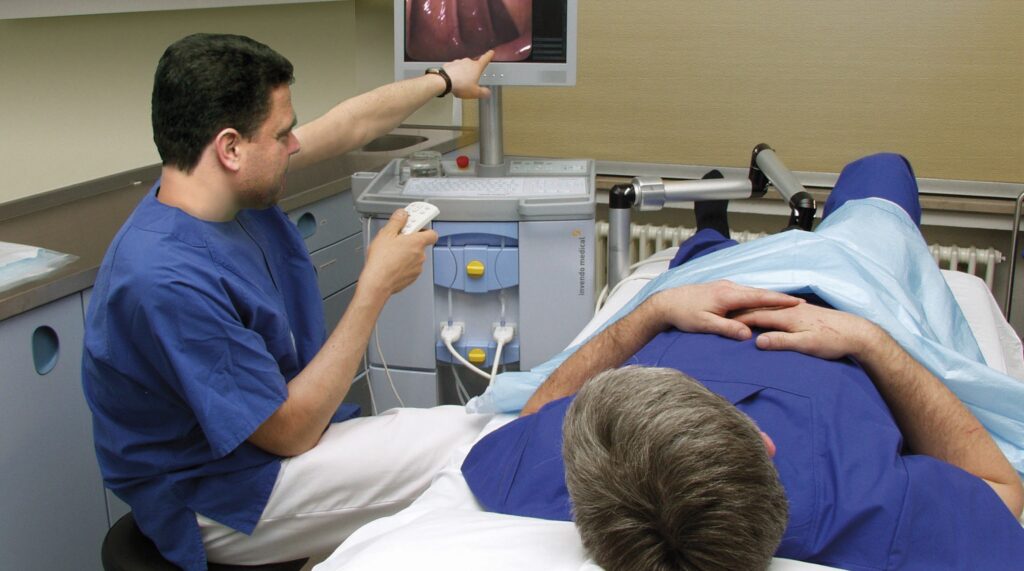Screening refers to testing to find a disease such as cancer in people who don’t have symptoms of that disease. For some types of cancer, screening can help find cancers at an early stage, when they are more easily cured.
Prostate cancer can often be found early by testing the amount of prostate-specific antigen (PSA) in a man’s blood. Another way to find prostate cancer early is the digital rectal exam (DRE).
Prostate-Specific Antigen (PSA) Blood Test
Prostate-Specific Antigen (PSA) is a substance made by cells in the prostate gland (both normal cells and cancer cells). PSA is mostly found in semen, but a small amount is also found in the blood. Most healthy men have levels under 4 nanograms per milliliter (ng/mL) of blood. The chance of having prostate cancer goes up as the PSA level goes up.
When prostate cancer develops, the PSA level usually goes above 4. Still, a level below 4 does not guarantee that a man doesn’t have cancer – about 15% of men with a PSA below 4 will have prostate cancer on a biopsy. Men with a PSA level between 4 and 10 have about a 1 in 4 chance of having prostate cancer. If the PSA is more than 10, the chance of having prostate cancer is over 50%.
If your PSA level is high, your doctor may advise either waiting a while and repeating the test, or getting a prostate biopsy to find out if you have cancer. Not all doctors use the same PSA cutoff point when advising whether to do a biopsy. Some may advise it if the PSA is 4 or higher, while others might recommend it at 2.5 or higher. Other factors, such as your age, race, and family history, may also come into play.
Digital Rectal Exam (DRE)
For a digital rectal exam (DRE), the doctor inserts a gloved, lubricated finger into the rectum to feel for any bumps or hard areas on the prostate that might be cancer. As shown in the picture below, the prostate gland is just in front of the rectum, and most cancers begin in the back part of the gland, which can be felt during a rectal exam. This exam can be uncomfortable (especially for men who have hemorrhoids), but it usually isn’t painful and only takes a short time.
DRE is less effective than the PSA blood test in finding prostate cancer, but it can sometimes find cancers in men with normal PSA levels. For this reason, it may be included as a part of prostate cancer screening.
If the results of either one of these tests are abnormal, further testing is needed to see if there is a cancer. If prostate cancer is found as a result of screening with the PSA test or DRE, it will probably be at an earlier, more treatable stage than if no screening were done.
Since using early detection tests for prostate cancer became fairly common in the United States (about 1990), the prostate cancer death rate has dropped. But it isn’t clear that this drop is a direct result of screening. It could also be caused by something else, like improvements in treatment.
There is no question that screening can help find many prostate cancers early, but there are limits to the prostate cancer screening tests used today. Neither the PSA test nor the DRE is 100% accurate. These tests can sometimes have abnormal results even when a man does not have cancer (known as a false-positive result), or normal results can occur even when a man does have cancer (known as a false-negative result). Unclear test results can cause confusion and anxiety. False-positive results can lead some men to have a prostate biopsy (with small risks of pain, infection, and bleeding) when they don’t have cancer. And false-negative results can give some men a false sense of security even though they actually have cancer.
Another important issue is that even if screening detects a cancer, doctors often can’t tell if the cancer is truly dangerous. Finding and treating all prostate cancers early might seem as if it would always be a good thing, but some prostate cancers grow so slowly that they would probably never cause problems. Because of an elevated PSA level, some men may be diagnosed with a prostate cancer that they would have never even known about at all. It would never have led to their death, or even caused any symptoms.
But these men may still be treated with either surgery or radiation, either because the doctor can’t be sure how quickly the cancer might grow and spread, or because the men are uncomfortable knowing they have cancer and not getting any treatment. Treatments like surgery and radiation can have urinary, bowel, and/or sexual side effects that can seriously affect a man’s quality of life.
Men and their doctors may end up struggling over whether they need treatment or whether they might be able to be followed without being treated right away (an approach called watchful waiting or active surveillance). Even when men are not treated right away, they still need regular blood PSA tests and prostate biopsies to determine the need for future treatment. These tests are linked with risks of anxiety, pain, infection, and bleeding.
Doctors are conducting large studies to see if early detection tests will lower the risk of death from prostate cancer. The most recent results from 2 large studies were conflicting, and didn’t offer clear answers.
Early results from a study done in the United States found that annual screening with PSA and DRE did detect more prostate cancers than in men not screened, but this screening did not lower the death rate from prostate cancer.
A European study did find a lower risk of death from prostate cancer with PSA screening (done about once every 4 years), but the researchers estimated that about 1,050 men would need to be screened (and 37 treated) in order to prevent one death from prostate cancer. Neither of these studies has shown that PSA screening helps men live longer (lowers the overall death rate).
Prostate cancer is often a slow-growing cancer, so the effects of screening in these studies may become clearer in the coming years. Both of these studies are being continued to see if longer follow-up will give clearer results. Several other large studies of prostate cancer screening are now going on as well.
At this time, the American Cancer Society recommends that men thinking about prostate cancer screening make informed decisions based on available information, discussion with their doctor, and their own views on the benefits and side effects of screening and treatment.
Until more information is available, you and your doctor should decide whether you should have tests for prostate cancer. There are many factors to take into account, including your age and health. If you’re young and develop prostate cancer, it may shorten your life if it’s not caught early. Screening men who are older or in poor health is less likely to help them live longer. This is because most prostate cancers are slow-growing, and men who are older or have major health problems are more likely to die from other causes before their prostate cancer grows enough to cause problems.
Source: http://www.cancer.org/

